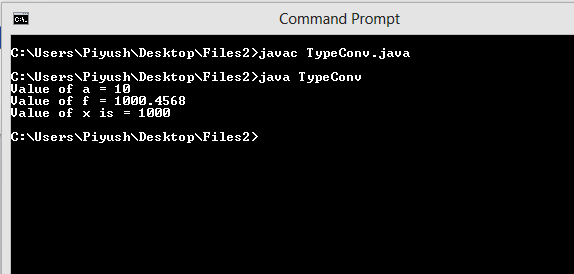Type Conversion In Java : Introduction
- Type conversion in java is the technique of converting one type (data-type) into other type.
- Type conversion in java can be done between compatible types and incompatible types. Compatible types are those which can be implicitly converted.
- For example : Conversion from byte to int is compatible, since int can hold a byte easily.
- Incompatible types are those which need to be explicitly converted by casting.
- For example : Conversion from int to byte is incompatible, since a byte is smaller than int and cannot hold it.
- Hence there are two types of type conversion in java :
- Implicit Type Conversion
- Explicit Type Conversion
Type Conversion In Java : The Discussion
- With type conversion being such an important topic, Let us discuss the two type conversion in java in details along with a sample program below.
-
Implicit Type Conversion
- As discussed implicit type conversion occurs for compatible types. Implicit type conversion is done automatically, and the destination data type should be larger is size than the source data type. Hence a widening conversion takes place.
- For example : Type Conversion from a float to a double is implicit type conversion.
-
Explicit Type Conversion
- Explicit type conversion occurs for incompatible types.
- Explicit type conversion is done forcefully by casting a larger type to smaller type. Since we are converting a large type to a smaller type, this conversion is also called narrowing conversion.
- Syntax for explicit casting can be defined as,
(required-type) value
- In the syntax required-type indicates the type to which the type of the value is to be converted. Value is the value of some variable.
- For example : Converting an int to a byte is done explicitly by casting int to byte.
int a = 10; byte b = (byte) a ; //Casting
Type Conversion In Java : Example
- Let us take an example to discuss both implicit and explicit type conversion:

Type Conversion In Java : Example

Type Conversion In Java : Output
- In the above output the value of double when casted to a float is truncated. This is because of the smaller size of float than double.
- Similarly conversion from double to int also truncates the fractional part as int only hold integer value.